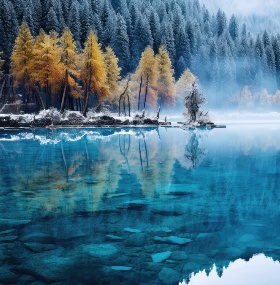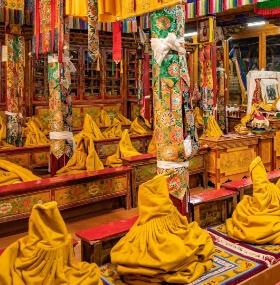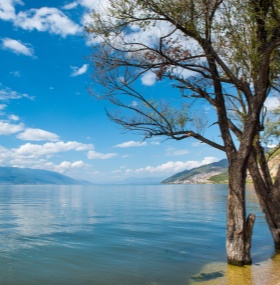Chinese Ethnic Minorities
Description
● An Introduction to Chinese National Culture
China is a multi-ethnic country with 56 ethnic groups, including the Han and 55 ethnic minorities. The Han Chinese are the most populous, accounting for about 91.51% of the country's total population, while the remaining 55 ethnic groups, collectively known as the minority nationalities, account for about 8.49% of the total population. These ethnic groups are located in various regions of China and have their own unique cultures, traditions and customs. For example, the Mongols are known for their grassland culture and hold the annual Naadam Conference; the Hui believe in Islam and have characteristic buildings such as mosques; the Tibetans believe in Tibetan Buddhism and have the Potala Palace as their landmark; and the Uyghurs are known for their rich culture of song, dance, and cuisine. Together, these ethnic groups constitute the multiculturalism of the Chinese nation, demonstrating China's richness, colorfulness and inclusiveness.
● Recommended Minority Nest Itinerary Destinations to Experience
Tibet - Tibetan
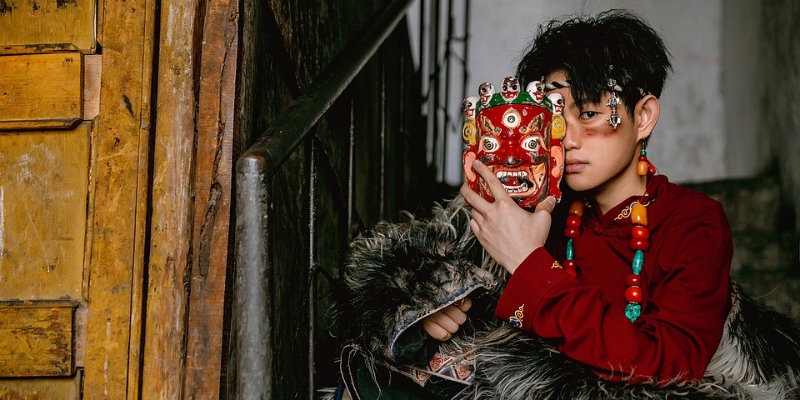
Costume:
Tibetan dress is represented by the Tibetan robe. Tibetan robe is the main clothing style of Tibetans, there are many kinds, from the texture can be divided into brocade, leather, serge, plain cloth and so on. The Tibetan robe is generally long, and when wearing it, the lower part should be lifted up, with the hemline thirty to forty centimeters high from the feet, and tied with a belt. In addition, Tibetan hats and Tibetan boots are also important features of Tibetan clothing.
Cuisine:
Ghee tea is a daily essential drink for the Tibetan people, made of ghee, tea and salt and other ingredients, with the effect of protecting against cold, refreshing and quenching thirst. Tsampa is the Tibetan people's staple food, from barley or peas fried and ground into fried noodles, and ghee tea together. Barley wine is a kind of low-grade wine brewed by Tibetan people from barley, which is suitable for both men and women. In addition, there are also specialties such as stewed chicken with matsutake mushrooms and cordyceps, air-dried yak meat, blood sausage, bacon, and Tibetan-style clay hot pot.
Cultural practices:
The Tibetan people believe in Tibetan Buddhism, and have many unique religious ceremonies and ways of praying for blessings, such as turning the sacred mountain, worshipping the sacred lake, spreading wind horse flags and hanging colorful sutra streamers. Tibetan festivals are colorful, such as the Tibetan New Year and the Snowdon Festival, which are important festivals for the Tibetan people. During the festivals, the Tibetan people will wear traditional national costumes, sing and dance to celebrate the harvest and reunion.
Landscape/Points:
Potala Palace is the landmark of Tibet and one of the holy places of Tibetan Buddhism. Namucuo is one of the largest lakes in Tibet, with clear and transparent water, surrounded by snow-capped mountains and stunning views. Mount Everest is the highest peak in the world. Standing at the foot of Mount Everest and looking up, you can feel the majesty and magnificence of nature. In addition, there are also famous Buddhist temples such as the Da Zhao Temple, Sera Monastery and Drepung Monastery, as well as historical and cultural relics such as the Zashilunbu Monastery and the ancient city of Gyantse, all of which are unmissable landscapes in Tibet.
Yunnan - Dai Nationality
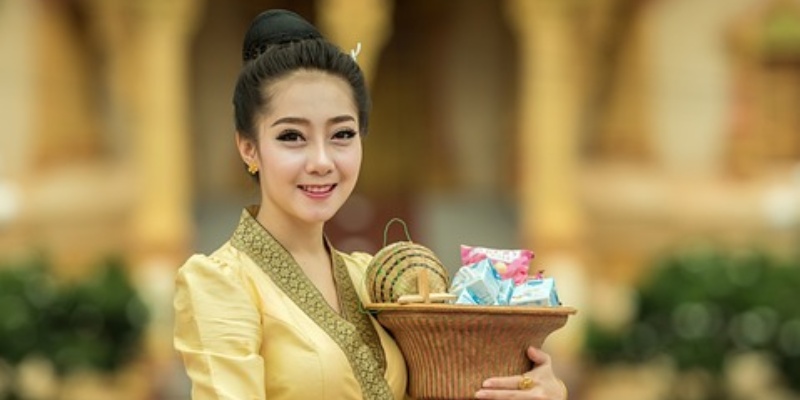
Costume:
The Dai dress is light and beautiful, both practical and highly decorative. Dai men usually wear collarless lapel or large lapel and small-sleeved short shirts with long pants, and wrap their heads with white cloth, water-red cloth or blue cloth. Dai women in Xishuangbanna wear tight underwear of various colors, tight collarless and narrow-sleeved shirts, and colorful tunic skirts, which are as long as their feet and are bound with fine silver belts. Dai women love to keep their hair long and tied at the top of their heads, some of them are decorated with combs or flowers, some of them are wrapped in head scarves, and some of them are wearing tall hats, each presenting its own show, each showing its own beauty.
Cuisine:
Dai cuisine is based on rice, and they are good at making all kinds of sour, spicy and cold dishes. Among them, Lemongrass Grilled Fish is one of the classic dishes of the Dai, in which cleaned fresh tilapia is marinated with lemongrass, chili powder and salt and then grilled. In addition, Dai bamboo rice is also a flavorful cuisine with national characteristics, made by baking glutinous rice in bamboo joints, with a soft and delicate texture and the fresh smell of bamboo.
Cultural customs:
The Dai people have rich cultural customs, the most famous of which is the Water Splashing Festival. The Water Splashing Festival is the grandest traditional festival of the Dai people, which is held in the middle of April every year, symbolizing the washing away of a year's bad luck and praying for an auspicious new year. On this day, people pour water on each other to show their blessings, and the whole festival is full of joy and peaceful atmosphere. In addition, the Dai people also have important religious festivals such as the Door Closing Festival and the Open Door Festival.
Landscape/Points:
Xishuangbanna is the center of Dai culture, where the tropical rainforest, Wild Elephant Valley, Menglun Botanical Garden and other natural landscapes are breathtaking. In addition, the traditional architecture of the Dai, the dry-rail bamboo buildings, is also a unique landscape. This form of architecture is adapted to the hot and humid climate of Yunnan and shows the wisdom and creativity of the Dai people. Strolling in the Dai villages, you can feel the strong ethnic atmosphere and unique cultural charm.
Guangxi - Zhuang Nationality
Costume:
The Zhuang costumes are generally referred to collectively as the Zhuang costumes, which are also known as the Luo Yue costumes or Yue costumes. Zhuang costumes are known for their colorfulness and exquisite patterns. In terms of dress, men are more plain, mainly in blue and black, while women are colorful and especially like to embroider their shoes, hats, and breast pockets with colorful silk threads with patterns, such as figures, birds, animals, and flowers, etc., which are colorful.
Cuisine:
The staple food of the Zhuang is mainly rice, supplemented by corn, taro, sweet potatoes and other miscellaneous grains. In the Zhuang area, rice and glutinous rice are the main food crops, and glutinous rice is especially loved and often used to make all kinds of dumplings, patties and cakes. The Zhuang people like to eat pork, chicken, duck, fish and other meat foods, and their specialties include white chopped chicken, roast pork and sashimi.
Cultural Practices:
The Zhuang people are warm and hospitable, and guests to Zhuang villages are regarded as guests of the whole village, and often several families take turns to invite for dinner to show their hospitality. And the Zhuang people can sing well, there are regularly held singing songs will be called song dike. During the Song Wei, there are also recreational activities such as throwing embroidered balls and "touching eggs" between men and women.
Landscape/Points:
Qin Zhuangzhai is built on the red elements and the beauty of the landscape, integrating Zhuang folklore and Tianqin culture. The scenic spot has natural landscapes such as ancient cauldron and dragon springs, as well as humanistic landscapes such as Zhuang pole-and-fence wooden buildings. Visitors can experience the Zhuang folk culture here and enjoy the beautiful landscape scenery. In addition, there are many other Zhuang landscapes worth visiting in Guangxi, such as Longji Terraces and Sanjiang Dong Wind and Rain Bridge.
Guizhou - Miao Nationality
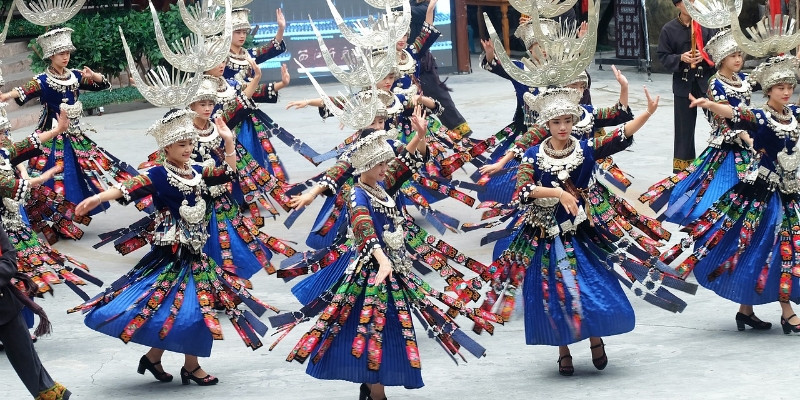
Costume:
Miao costumes vary from region to region, but generally have distinctive national characteristics. Women's clothing usually includes blouses, pleated skirts, ribbons and waistbands, etc. The blouses are mostly short, with lapel or slanting lapels, and are embroidered with exquisite patterns and motifs; the pleated skirts are colorful, and the hems of the skirts are trimmed with laces or tassels; and the ribbons and waistbands play the dual roles of decorations and practicality. Men's clothing is relatively simple, mostly for the lapel or left lapel short clothes, wearing long pants, bundled with a large belt, head wrapped in a long green scarf. Miao silver jewelry is also a highlight of their costumes, such as large silver horns, silver combs, silver earrings, etc., with unique shapes and exquisite craftsmanship.
Cuisine:
Miao cuisine is mainly sour and spicy, with unique taste, color and flavor. The most representative cuisines include sour soup fish, Miao family bacon, Miao family patties and so on. Fish in Sour Soup is a traditional dish of the Miao people, which is made with sour soup as the base and fresh fish slices, which is sour, spicy and memorable. Miao home bacon is pork cured by the Miao people using a special process, with a mellow taste and aroma. Miao patties are made of high-quality glutinous rice steamed, mashed into mud and then kneaded into small round cakes, with a soft and sweet taste, which is a favorite traditional food of the Miao people.
Cultural customs:
The Miao have many traditional festivals, such as the Year of the Miao and the Sisters' Festival, during which grand celebrations are held, such as bullfights, horse races and songs, demonstrating the unity and vigor of the Miao people. Miao marriage and funeral customs are also unique, such as the marriages of young Miao men and women are mostly determined by autonomous marriages, through socializing and talking about love; while funerals have strict rituals and customs.
Landscape/Points:
Xijiang Thousand Households Miao Village, which is one of the largest and oldest Miao settlement villages in China. The dangling footstool complexes of Xijiang Thousand Households Miao Village are grand in scale and staggered on the hillside, harmonizing with the surrounding natural environment. Visitors can enjoy the traditional architectural art and exquisite silver jewelry of the Miao, as well as taste the authentic Miao cuisine and experience the strong cultural atmosphere of the Miao. In addition, there are many other Miao-inhabited villages and attractions in Guizhou, such as Langde Shangzhai and Leishan Miaozhai, which are good places for tourists to learn about the culture and flavor of the Miao.
Sichuan - Yi Nationality
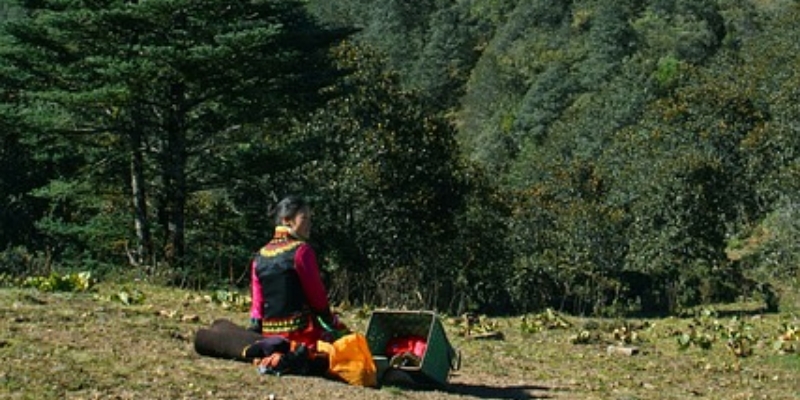
Costume:
The Yi costumes are varied, richly patterned and skillfully crafted, mostly handmade from pure wool. Common decorative elements in the costumes include patterns of animals, plants and living objects such as cock's crowns, sheep's horns, window panes, etc. The colors are mainly black, red and yellow, which represent the earth, flames and bountiful harvests respectively. In addition, the Yi people have a fondness for silver jewelry, which plays an important role in their costumes, such as embellished bubble headdresses, openwork neckpieces, breastplates, rings and other favorite accessories of Yi women.
Cuisine:
The Yi cuisine is unique for its distinctive flavoring and cooking methods, with spicy, sour and numbing tastes. The staple food of the Yi is corn, wheat, buckwheat, barley and other miscellaneous grains, and they also like to eat meat and spicy food. One of the most representative food of the Yi people is Tuotuo meat, which is made of moderately fat and thin pork cut into large pieces, marinated with special spices and then cooked, with tender meat and full of flavor. In addition, the Yi people's pickled vegetable soup, buckwheat poop, Yi family emery chicken, Lianjia vegetable, spicy soup chicken, mutton rice noodles and other popular food.
Cultural customs:
The Torch Festival is the grandest traditional festival of the Yi ethnic group, which is usually held in the evening of the 24th to 26th day of the 6th lunar month. During the festival, the villages will be tied into a large torches erected in the village, the door of each house will also be erected small torches, lit at night, the village is bright. People sing and dance around the torches to celebrate the festival. The origin of the Torch Festival is related to the worship of fire, and the purpose of the festival is to drive away insects and pests with fire and protect the growth of crops.
Landscape/Points:
Liangshan Yi Autonomous Prefecture is one of the major settlements of the Yi people, with beautiful mountains and rivers and rich natural resources. Tourists can go to Xichang City, the capital of Liangshan Yi Autonomous Prefecture, and visit attractions such as the Ethnic Style Park of Liangshan Yi Autonomous Prefecture to learn more about the culture and flavor of the Yi people. In addition, there are many Yi villages and natural landscapes in the Liangshan area, such as Lugu Lake and Mount Lunjun, which are good places for tourists to experience the Yi culture and natural scenery.
Xinjiang -Uyghur Nationality
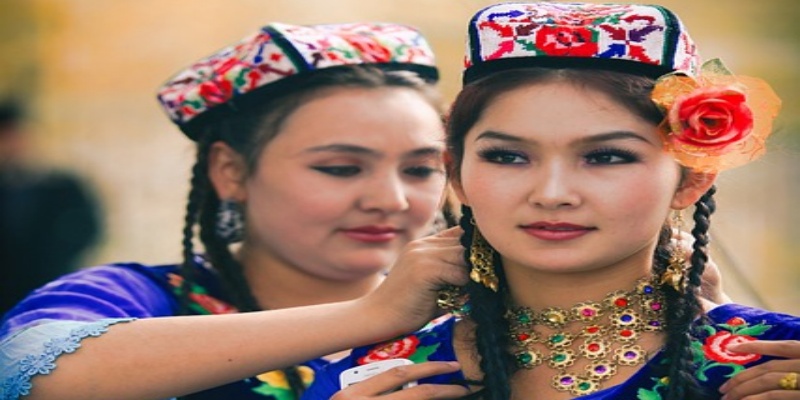
Costume:
Uyghur costumes are famous for their rich colors, unique patterns and exquisite craftsmanship. In traditional Uyghur costumes, men wear knee-length, wide-sleeved, collarless, unbuttoned tunics called "lined tabs" with a long scarf tied around the waist in dark colors such as black, brown and blue. Women generally wear dresses, covered with a kangaroo or blouse, in bright colors, preferring contrasting colors, such as red and green. In addition, the Uyghur people like to decorate their clothes with embroidery, whether it's hats, clothes or shoes, all of which are filled with exquisite embroidery patterns.
Cuisine:
Common Uyghur cuisines include hand-held rice, naan, grilled meat and baked buns. Hand-rolled rice is made of rice, mutton, carrots and other ingredients simmered together for a delicious flavor. Naan is a round cake made from flour and is one of the staple foods of the Uyghur people. Kebab is made by skewering lamb on an iron skewer, which is charred on the outside and tender on the inside, and is full of flavor. In addition, there are other delicacies such as pulled pork, thin-skinned buns, oil tartar, milk lumps, and mareen candy, each of which has its own unique preparation method and flavor.
Cultural customs:
Uyghur cultural customs are rich and diverse, reflecting their unique ethnic flavor. The Uyghurs have unique ceremonies and customs for important moments in life such as naming ceremony, bed-shaking ceremony, circumcision, wedding and funeral. Wedding is one of the grandest Uyghur celebrations, usually lasting three days, during which there are dances, song performances, polo matches and other colorful activities.
Landscape/Points:
The Uyghur region of Xinjiang is home to many magnificent natural landscapes and unique humanistic landscapes. Among them, Tianshan Tianchi, Kanas Lake and Sayram Lake are famous natural landscapes, attracting countless tourists with their beautiful landscapes. In addition, the areas inhabited by Uyghurs have many buildings and attractions with national characteristics, such as the Old City of Kashgar and Turpan Grapevine.
Related Posts
Create Your Customized Trip
Take about 2 minutes to fill the form to tell us how you like to travel, and get a reply within 1 working day.
